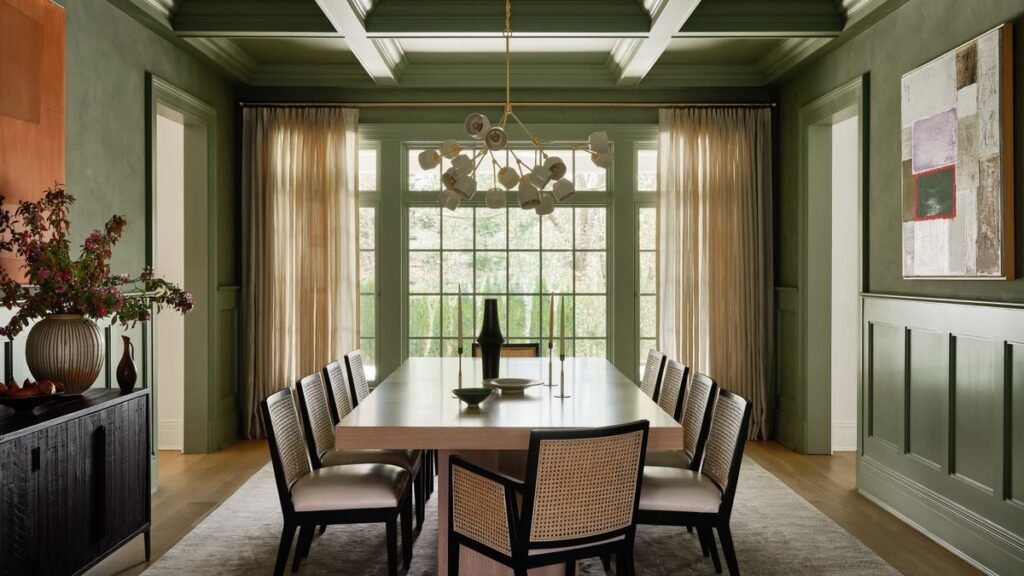I love color. I really do. But when it comes to my own home, I tend to stick to a more neutral palette. Mainly because picking different colors that go together is a lot harder than it looks, and I have a certain aversion to accent walls. But I think I may have found the solution: lots of color.
Color drenching is a decor trend currently sweeping the design world—and the rooms we live in. The technique involves painting every surface in a space (walls, ceilings, cabinets, trim, baseboards, even floors, if you’re feeling bold) with the same solid color, creating a monochrome space that draws you in and delights the senses.
But simply painting your ceiling and walls the same color isn’t enough. “Filling a room with color is like wrapping it in color,” says Whitney Romanoff, owner and principal designer at Northwest Arkansas-based studio Meet West. “The monochromatic cocoon effect creates a defined atmosphere and draws you into the space.”
Not only does it save you the trouble of having to decide on a paint color, it’s also a more cost-effective option than wallpapering or painting a room a contrasting color. Convinced? So do I. But we know it’s not as easy as it looks. So we asked the experts for everything you need to know about painting to help make your room look impactful rather than drab.
What is Color Drenching?
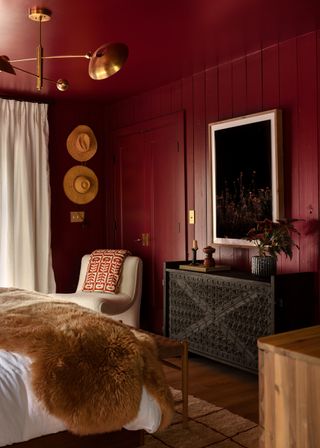
(Image courtesy of Rett Peek. Design by Meet West)
As mentioned above, color drenching is a painting trend where you paint your ceilings, walls, trim, cabinets and baseboards all the same color – meaning you paint every surface in a single tone – and it can also be applied to your furniture and décor choices to create a unified, monochromatic effect that dramatically impacts the mood of a room.
They can also be used to define different areas within a home, representing specific activities or moods designated for those spaces. “When you come into this bedroom from the warm whites of the home’s social spaces, you feel like you can just drop your shoulders a little, be quiet, and lose yourself in your thoughts,” says Whitney Romanoff of her decision to paint the bedroom, pictured above, a rich auburn. “The color indicates that you’re entering a separate, private realm.”
What are the benefits of color drenching?
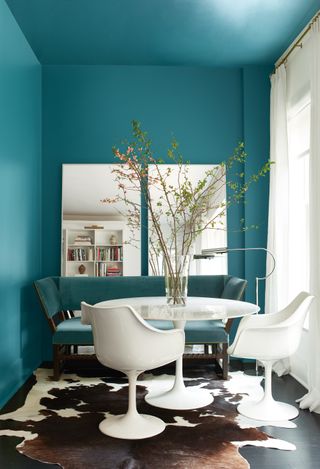
(Image courtesy of Benjamin Moore)
Not only does color drenching only require you to choose one color of paint for your space, eliminating the need for detailed work like taping off ceilings and trim or cutting in, but there are also many aesthetic benefits to color drenching a space.
Firstly, it’s a great way to virtually erase unattractive parts of a room like air conditioning units, attic doors, vents, etc., but it can also dramatically change the way you feel when you’re in the space.
“I think people are tired of the typical wall colors with contrasting trim or baseboards, and the same old white ceiling treatments,” Whitney says. “White trim blocks the eye, adds extra information to process, and distracts from the more interesting details of the room. Removing that contrast leaves the space easier on the eye and allows the architectural details to stand out more.
It’s also not as overwhelming as you might first expect. “Filling a space with color simultaneously maximizes and minimizes it,” explains Susana Simonpietri, creative director at Brooklyn-based architecture firm Chango. “If the room had a monochromatic color scheme, you’d be making a bold design decision that would create a big impact, but at the same time it normalizes the colors, making them feel more neutral.” And the result is calming.
What are the best colors for color drenching?
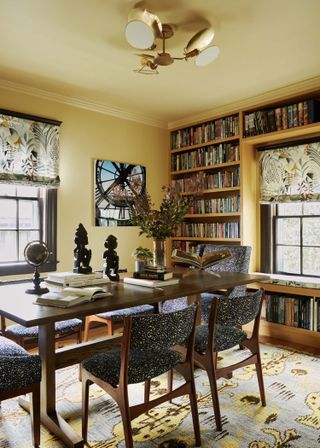
(Image courtesy of Jared Kuzia. Design by Casagrande Studio)
Just like when choosing any paint color for your home, always go with your personal preference. It’s important to pick a color you won’t tire of, considering it’ll be a big part of the final design. The best color for drenching is one you love, whether it’s light or dark. Designers I spoke with agree.
“My client’s husband had a secondary role in the overall design decisions for the house, but he wanted to use his favorite bright color, yellow, in his home office,” explains Cecilia Casagrande, founder of Boston-based interior design firm Casagrande Studio. “So for contrast, we painted the walls, trim, and ceiling in Farrow & Ball’s Hay, and the bookshelves in Farrow & Ball’s India Yellow.”
It’s also said that you shouldn’t be afraid to embrace darker tones: Whitney Romanoff believes that while a burst of colour can work with anything, she’s particularly drawn to “earthy, muddy tones” that give the most impact.
Meanwhile, Susana Simonpietri of Chango, pictured below, decided to color drench her own breakfast nook in a surprisingly light shade: white. “Because you’re working with a blank canvas, I think the furniture really pops,” she explains. “This is an example of how you can color drench in a very neutral way.”
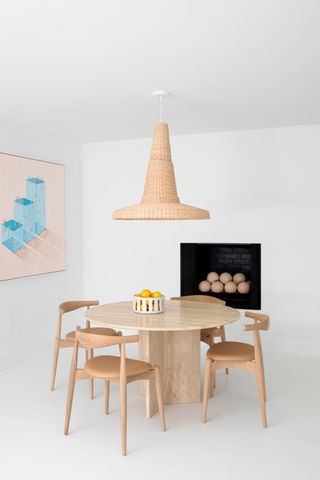
(Image courtesy of Sarah Elliott. Design by Chango)
So, when it comes to the best colors for color drenching, there really are no rules: “Color is subjective and ultimately comes down to personal preference,” says Arianna Barone, color expert at paint brand Benjamin Moore, who recommends thinking about how the color makes you feel.
“You can also use gorgeous jewels. [Benjamin Moore’s] “For an elegant and sophisticated feel, try ‘Beau Green’ or ‘North Sea Green’,” she adds. “Or try deeper, muted colours like ‘Regent Green’ or ‘Beaujolais’ for a chic yet cosy feel. For a more playful and bright space, try colours like ‘Tranquil Blue’ or ‘Proposal’.”
What is the best sheen for color drenching?
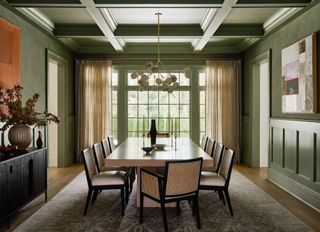
(Image courtesy of Read McKendree. Design by Chango)
Sometimes it’s not as simple as picking out a single can of paint and painting a room over with. Flooding a room with a single color runs the risk of it looking monotonous and lacking the contrast that would add interest and depth. But that can easily be fixed by trying out different paint finishes in the same shade.
“Sheen can be used as an additional design element in a space,” explains Ariana Barone of Benjamin Moore. “For example, a glossy wall can reflect additional light around the space, creating an extra sense of drama.”
As for the best sheen to apply the color to, Ariana recommends semi-gloss or high gloss for trim, satin or flat paint for ceilings, and eggshell finish for walls.
Susana Simonpietri says it really depends on your space and how much natural light it gets in. “We usually choose a matte finish that absorbs the light,” she says. “This works really well when using darker colors, and it doesn’t reflect too much, so the color stays consistent throughout.”
If your room has lots of natural light, Susana suggests using a glossier paint, which will help reflect the light throughout the room. “Matte finishes will give a more subdued look, while glossy paints will give a more formal and glamorous look,” she adds.
But using different finishes will also affect the appearance of the colour, which can be tricky if you want to achieve a consistent, cohesive look. Matching limewash or premixed plaster can be particularly tricky, as seen in the living room above. “If you’re using a matt finish, you also need to consider that it dries differently to a satin finish, so you might choose a darker colour to complement the sheen of the satin finish,” adds Susana.
What room is best for a colorful space?
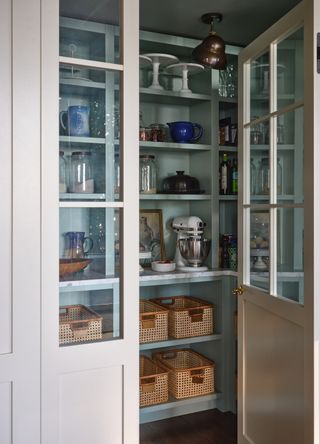
(Image courtesy of Michael Clifford. Design by Lisa Staton Design)
Applying loads of color can work in just about any room in your home, with the possible exception of large open-plan spaces (where it can be hard to know when to start and finish), but most designers I spoke to agree that it’s the smaller spaces in your home where this wall painting idea really works.
Think enclosed foyers, powder rooms, and even kitchen pantries. “While I think color can work well in any type of room, dining rooms, dens, studies, and media rooms are great spaces to experiment with,” says Susana.
Like ceiling wallpaper, filling a small room with color can blur the boundaries of the room and make it feel larger than it actually is. It’s also a great option for rooms that don’t get a lot of natural light, helping to bring in the dark and create a cozy, cocoon-like effect.
“By choosing a darker drenching color, you can embrace the natural feel of the room, rather than covering the trim or white ceiling with a light color that clashes with the room’s atmosphere,” Whitney says.
Is color drenching just about paint?

(Image courtesy of Rett Peek. Design by Meet West)
Using plenty of color isn’t just limited to paint; it can also apply to the upholstery and decorative item choices within a space. Whitney Romanoff recalls being brought on to a design project where her client had already chosen dark blue grasscloth wallpaper for a bedroom (pictured above).
“I matched the trim and ceiling to the grasscloth walls and added vintage velvet curtains in a similar hue, continuing the tone-on-tone effect of soft finishes,” she explains.
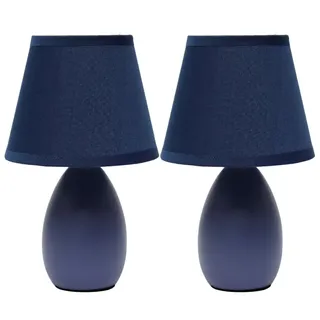
Ceramic lamp with matching shade
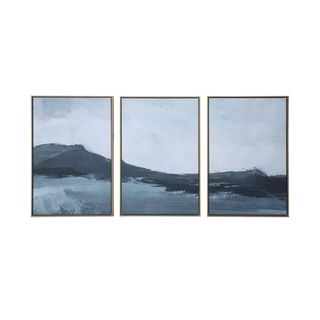
Abstract Mountain Triptych Floating Wall Canvas
price: $103.99
was: $129.99
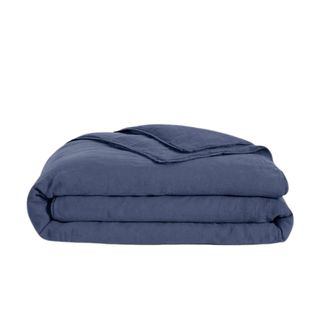
Washed linen duvet cover in indigo
price: From $208.25
was: $245
How do you style a room full of color?
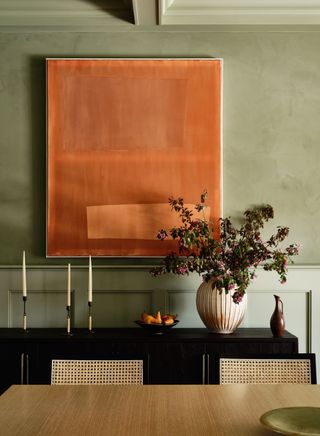
(Image courtesy of Read McKendree. Design by Chango)
One way to decorate a colorful room is to choose styling that matches your chosen color palette, but another way is to use items in the room to create contrast.
“When using color drenching, not all items have to be the same color,” says Susana. “It’s fine to use a variety of materials and colors throughout, as long as they don’t detract from the overall vibe or clash too much.”
To achieve this, she recommends flooding the room’s largest surfaces, then occasionally adding furniture pieces in complementary and contrasting colors to add contrast.
Use lots of color — This may seem like a bold statement, but it’s actually a great place for anyone who is nervous about using color in their home. Accent walls have a softer effect than accent walls, which can often feel out of place or out of place.
It’s a way to instantly make a space feel more inviting, and a clever way to help you make the most of a dark room. Using lots of color can add personality to the smallest spaces in your home, like a powder room or kitchen pantry, and can even make them feel bigger than they actually are by blurring boundaries.
All you need is one color.

